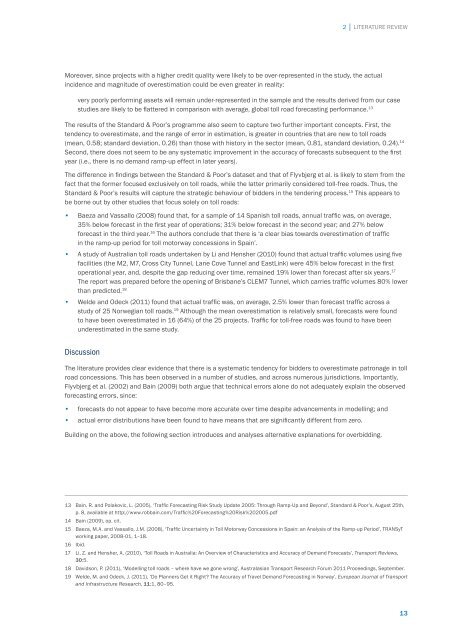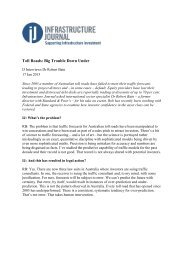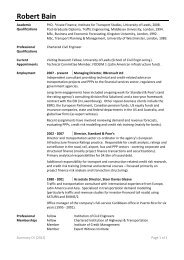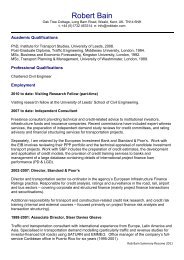Disincentivising overbidding for toll road concessions
Disincentivising overbidding for toll road concessions
Disincentivising overbidding for toll road concessions
- No tags were found...
Create successful ePaper yourself
Turn your PDF publications into a flip-book with our unique Google optimized e-Paper software.
2 │ LITERATURE REVIEW<br />
Moreover, since projects with a higher credit quality were likely to be over-represented in the study, the actual<br />
incidence and magnitude of overestimation could be even greater in reality:<br />
very poorly per<strong>for</strong>ming assets will remain under-represented in the sample and the results derived from our case<br />
studies are likely to be flattered in comparison with average, global <strong>toll</strong> <strong>road</strong> <strong>for</strong>ecasting per<strong>for</strong>mance. 13<br />
The results of the Standard & Poor’s programme also seem to capture two further important concepts. First, the<br />
tendency to overestimate, and the range of error in estimation, is greater in countries that are new to <strong>toll</strong> <strong>road</strong>s<br />
(mean, 0.58; standard deviation, 0.26) than those with history in the sector (mean, 0.81, standard deviation, 0.24). 14<br />
Second, there does not seem to be any systematic improvement in the accuracy of <strong>for</strong>ecasts subsequent to the first<br />
year (i.e., there is no demand ramp-up effect in later years).<br />
The difference in findings between the Standard & Poor’s dataset and that of Flyvbjerg et al. is likely to stem from the<br />
fact that the <strong>for</strong>mer focused exclusively on <strong>toll</strong> <strong>road</strong>s, while the latter primarily considered <strong>toll</strong>-free <strong>road</strong>s. Thus, the<br />
Standard & Poor’s results will capture the strategic behaviour of bidders in the tendering process. 15 This appears to<br />
be borne out by other studies that focus solely on <strong>toll</strong> <strong>road</strong>s:<br />
••<br />
Baeza and Vassallo (2008) found that, <strong>for</strong> a sample of 14 Spanish <strong>toll</strong> <strong>road</strong>s, annual traffic was, on average,<br />
35% below <strong>for</strong>ecast in the first year of operations; 31% below <strong>for</strong>ecast in the second year; and 27% below<br />
<strong>for</strong>ecast in the third year. 16 The authors conclude that there is ‘a clear bias towards overestimation of traffic<br />
in the ramp-up period <strong>for</strong> <strong>toll</strong> motorway <strong>concessions</strong> in Spain’.<br />
••<br />
A study of Australian <strong>toll</strong> <strong>road</strong>s undertaken by Li and Hensher (2010) found that actual traffic volumes using five<br />
facilities (the M2, M7, Cross City Tunnel, Lane Cove Tunnel and EastLink) were 45% below <strong>for</strong>ecast in the first<br />
operational year, and, despite the gap reducing over time, remained 19% lower than <strong>for</strong>ecast after six years. 17<br />
The report was prepared be<strong>for</strong>e the opening of Brisbane’s CLEM7 Tunnel, which carries traffic volumes 80% lower<br />
than predicted. 18<br />
••<br />
Welde and Odeck (2011) found that actual traffic was, on average, 2.5% lower than <strong>for</strong>ecast traffic across a<br />
study of 25 Norwegian <strong>toll</strong> <strong>road</strong>s. 19 Although the mean overestimation is relatively small, <strong>for</strong>ecasts were found<br />
to have been overestimated in 16 (64%) of the 25 projects. Traffic <strong>for</strong> <strong>toll</strong>-free <strong>road</strong>s was found to have been<br />
underestimated in the same study.<br />
Discussion<br />
The literature provides clear evidence that there is a systematic tendency <strong>for</strong> bidders to overestimate patronage in <strong>toll</strong><br />
<strong>road</strong> <strong>concessions</strong>. This has been observed in a number of studies, and across numerous jurisdictions. Importantly,<br />
Flyvbjerg et al. (2002) and Bain (2009) both argue that technical errors alone do not adequately explain the observed<br />
<strong>for</strong>ecasting errors, since:<br />
••<br />
<strong>for</strong>ecasts do not appear to have become more accurate over time despite advancements in modelling; and<br />
••<br />
actual error distributions have been found to have means that are significantly different from zero.<br />
Building on the above, the following section introduces and analyses alternative explanations <strong>for</strong> <strong>overbidding</strong>.<br />
13 Bain, R. and Polakovic, L. (2005), ‘Traffic Forecasting Risk Study Update 2005: Through Ramp-Up and Beyond’, Standard & Poor’s, August 25th,<br />
p. 8, available at http://www.robbain.com/Traffic%20Forecasting%20Risk%202005.pdf<br />
14 Bain (2009), op. cit.<br />
15 Baeza, M.A. and Vassallo, J.M. (2008), ‘Traffic Uncertainty in Toll Motorway Concessions in Spain: an Analysis of the Ramp-up Period’, TRANSyT<br />
working paper, 2008-01, 1–18.<br />
16 Ibid.<br />
17 Li, Z. and Hensher, A. (2010), ‘Toll Roads in Australia: An Overview of Characteristics and Accuracy of Demand Forecasts’, Transport Reviews,<br />
30:5.<br />
18 Davidson, P. (2011), ‘Modelling <strong>toll</strong> <strong>road</strong>s – where have we gone wrong’, Australasian Transport Research Forum 2011 Proceedings, September.<br />
19 Welde, M. and Odeck, J. (2011), ‘Do Planners Get it Right The Accuracy of Travel Demand Forecasting in Norway’, European Journal of Transport<br />
and Infrastructure Research, 11:1, 80–95.<br />
13






